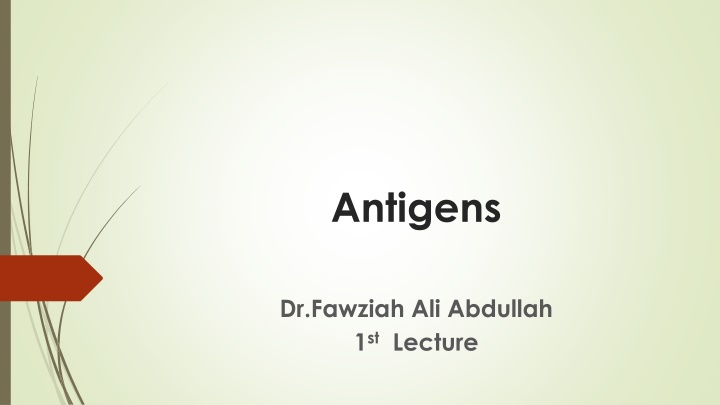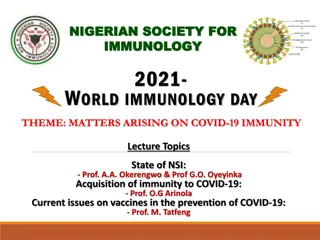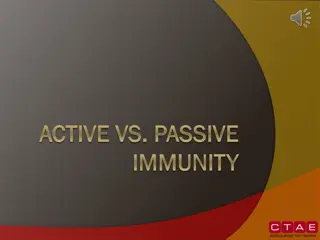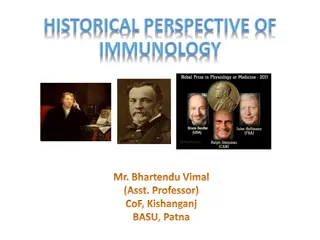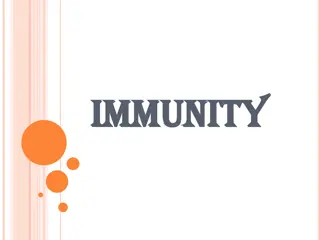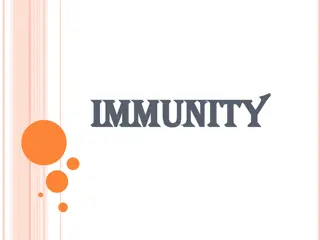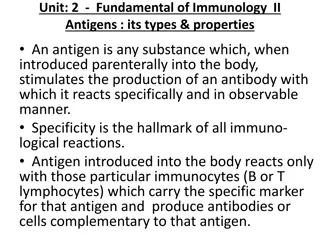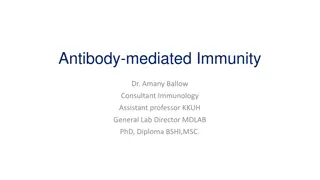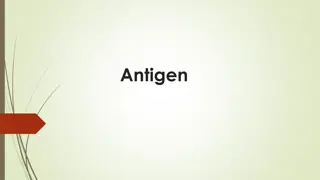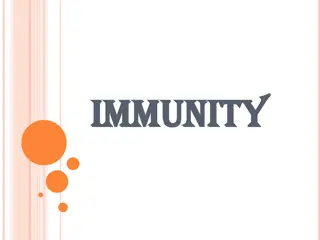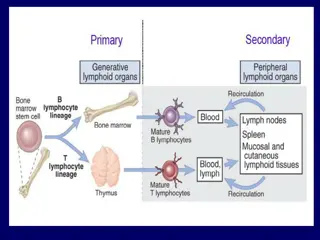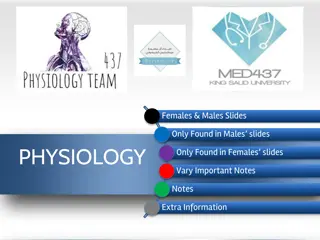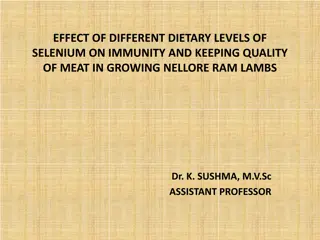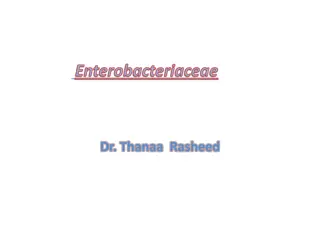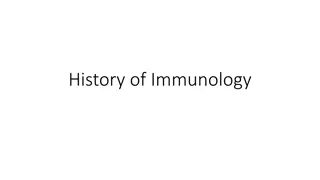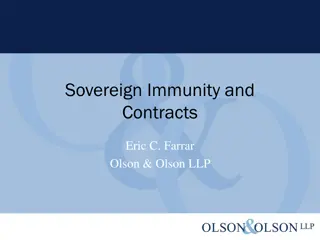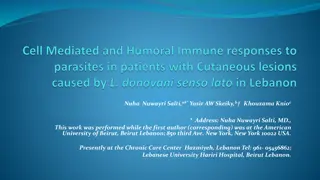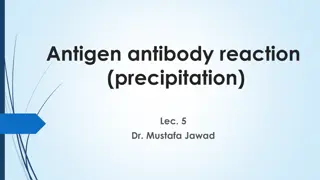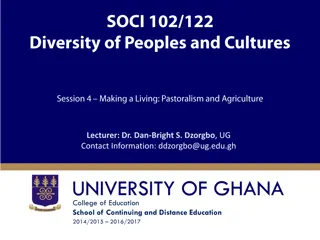Immunity: Antigens, Definitions, and Innate & Adaptive Responses
Immunity, a universal biological phenomenon, comprises innate and adaptive immunity mechanisms. Innate immunity involves physical barriers, microbial antagonism, and cytotoxicity, while adaptive immunity develops immune memory and various cell-mediated responses. Explore the fascinating world of immunology with Dr. Fawziah Ali Abdullah's insights.
Download Presentation

Please find below an Image/Link to download the presentation.
The content on the website is provided AS IS for your information and personal use only. It may not be sold, licensed, or shared on other websites without obtaining consent from the author.If you encounter any issues during the download, it is possible that the publisher has removed the file from their server.
You are allowed to download the files provided on this website for personal or commercial use, subject to the condition that they are used lawfully. All files are the property of their respective owners.
The content on the website is provided AS IS for your information and personal use only. It may not be sold, licensed, or shared on other websites without obtaining consent from the author.
E N D
Presentation Transcript
Antigens Dr.Fawziah Ali Abdullah 1stLecture
Definitions Immunity (Latin immunitas ) is a universal biological phenomenon that develops many programs based on the unique genotype of the body ( self ) in foreign surroundings, from the birth of the body to its death. There are two major types of immunity, innate immunity, which is phylogenetic and polyspecific, and adaptive immunity, which is acquired during an ongoing individual life. Immunology is a life science that studies the immune system, immunological mechanisms, and immunopathology in humans, animals, and other living beings. In contrast to other systems, the immune system is responsible for support of the balance or homeostasis between non-self, self, and former self. The end effects of two major types of immunological mechanisms, innate immunity and adaptive immunity, may be: 1. Immune containment of infection and tumors 2. Immune clearance of the infection and tumors
Innate Immunity The innate immune subsystem upon activation has a wide array of recruited molecules and cells, which may destroy invading pathogens very quickly but not very effectively. 1. Physical and chemical barriers: -Keratinization in the skin -Mucus formation on the mucosal epithelium and ciliary clearance in the respiratory tract -Production of various antimicrobial factors such as lysozyme, lactic and fatty acids, etc. in secretions -Deactivation of dangerous microbes by digestive enzymes and peristalsis in the GI tract
Innate Immunity 2. Microbial antagonism to pathogenic microbes due to the body s own mutualistic and commensal microorganisms 3. The liver due to oxidation of xenobiotics, detoxification, and synthesis of many defense factors 4. Cytotoxicity by complement 5. Phagocytosis and NETosis 6. Acute phase reaction (C-reactive protein, serum amyloid A, mannose-binding lectin, etc.) 7. Natural antibodies produced by CD5+B cells 8. Antimicrobial peptides such as defensins, cathelicidins, lactoferrin, dermicidin, etc. 9. Natural cytotoxicity due to innate lymphoid cells (ILCs) including N cells, NKT cells, and cells plus natural cytostasis induced by interferons (IFNs)
Adaptive Immunity The adaptive immune responses take some days and weeks to be finished. However, they are more effective in eliminating invading pathogens than the innate immunity. Furthermore, they develop the immune memory to the invading pathogens -Cell-Mediated (Humoral) Responses 1-Simple B-cell response formation of only one class of immunoglobulins, IgM, but no long-term memory. This type of response may be triggered by patterns too. 2. Advanced B-cell response switching antibodies after each other: IgM, IgG, IgA, and even IgE, and inducing the formation of long-lived memory plasma cells and lifelong memory B cells.
Adaptive Immunity -Cell-Mediated Responses 1- Inflammatory CD4+T-cell response that leads to the production of effector CD4+T cells and the lifelong memory CD4+T cells. 2-Cytotoxic CD8+T-cell response, which results in the formation of cytotoxic CD8+T cells capable of apoptosis in target cells and lifelong memory CD8+T cells.
Antigens and Patterns Antigen is a substance triggering the immune responses to constitute memory to this antigen. Antigens may be originated from non-self, former self, and even self. "Antigens are categorized as complete and incomplete (haptens), T dependent and T independent, and specified forms like antigens of pathogens, allergens, tumor antigens, autoantigens . Molecular patterns are low-molecular substances evoking the reactions of innate immunity with no memory. There are pathogen-associated molecular patterns (PAMPs), allergen- associated molecular patterns (AAMPs), damage-associated (DAMPs), and tumor-associated molecular patterns (TAMPs). molecular patterns
Antigens An antigen is a substance containing such information about non-self, self, and/or former self, which can trigger immune responses in the body to induce a very long and even lifelong memory to the event if it occurs. T-cell receptor (TCR) and B-cell receptor (BCR) can recognize antigens. Antigens of self are named autoantigens (or self- antigens),whereas tumor antigens present in fact former self The antigens may be divided into complete and incomplete antigens ( Table 1.1).
Antigens Immunogens Any antigen as an Immunogens may trigger an immune response, i.e., the interaction of many cell types of the immune system, which leads to the formation of new cell types destroying the antigen-containing pathogen and commonly keeping a memory about this event for a long time. Naturally, vaccines contain only immunogens. Tolerogen an antigen as a tolerogen triggers immune tolerance, another type of interaction of cells of the immune system. Alternatively, it results in the specific immunological silence when none is killed and no tissues are damaged.
Antigens Antigenicity, specificity, and immunogenicity structurally and functionally characterize antigens. -Antigenicity is the quality of an antigen to serve ligand for a receptor. The receptors for antigens are TCR and BCR. - Specificity is the antigen quality to be a unique molecule for only one receptor. -Immunogenicity is the quality to induce the adaptive immune responses of different power.
Antigens An determinant is an informational unit of the antigen specificity. In the antigen epitope may be dominant or latent (see . Fig. 1.1). A carrier, the non-information part of the antigen molecule, is required for any antigen to be complete epitope or antigenic molecule, an
Antigens The majority of antigens are T dependent since they require the participation of helper T cells to constitute memory cells T-independent antigens are capable of activating B cells on their own. In the past, there was a division of T- independent antigens into two types: type 1 (currently they all refer to PAMPs ) and type 2, which comprised highly repetitive polysaccharides of encapsulated bacteria. Type 2 T- independent antigens can interact with many BCRs in a crosslinking manner and activate only mature B cells, whereas immature B cells remain anergized. surface epitopes, e.g.,
Patterns pathogen-associated molecular patterns (PAMPs) Small exogenous molecules which contain a conserved motif,, are linked to a certain component of microbes. There are bacterial flagellin, peptidoglycan, lipopolysaccharide (endotoxin, LPS), viral dsRNA, and unmethylated CpG motifs of DNA. They may initiate different reactions of the innate immunity and do not induce immune memory
Patterns Allergen-associated molecular patterns (AAMPs) Other exogenous molecules, oligomeric components of allergen molecules, which may promote cross-reactivity of IgE allergy Tumor-associated molecular patterns (TAMPs) are low-molecular conserved components of tumor cells. On the one hand, they can upregulate innate defense against tumors, but, on the other hand, TAMP may, like a double-edged sword, promote cancer growth and metastasis through weakening immune surveillance,
Patterns Damage-associated molecular patterns (DAMPs) Some endogenous molecules,, are released outside the cell because of its injury. There are heat-shock proteins, extracellular matrix s (ECM s) proteins,S100, hyaluronan fragments, and nonprotein substances such as DNA, ATP, uric acid, and heparin. In physiological conditions, DAMPs serve structural and metabolic functions, being inaccessible to the immune system. From a clinical point of view, in case of severe damage to own tissue, they may trigger peracute inflammation and toxification and promote toxic shock syndrome.
Patterns All the patterns evoke similar reactions of the innate immunity. They are recognized by Toll-like receptors (TLRs) and other pattern recognition receptors (PRRs). Pattern recognition receptors (PRRs) are molecules expressed by cells of the innate immunity, which are capable of sensing patterns, triggering the reactions of innate immunity such as inflammation and taking part in adaptive immune responses. To date, five families of PRRs have been described, as follows 1-Toll-like receptors (TLRs) 2. C-type lectin receptors (CLRs) 3. NOD-like receptors (NLRs):NLR (nucleotide-binding domain leucine-rich repeat containing). different set of NLRs induces caspase-1 activation 4. RIG-1-like receptors (RLRs):RIG-I (retinoic acid-inducible gene I) is a cytosolic pattern recognition receptor (PRR) responsible for the type-1 interferon (IFN1) respons.They are sentinels for intracellular viral RNA that is a product of viral infection 5. AIM-2-like receptors (ALRs): Melanoma 2 (AIM2)-like receptors (ALRs) are a newly characterized class of pathogen recognition receptors (PRRs) involved in cytosolic and nuclear pathogen DNA recognition.
